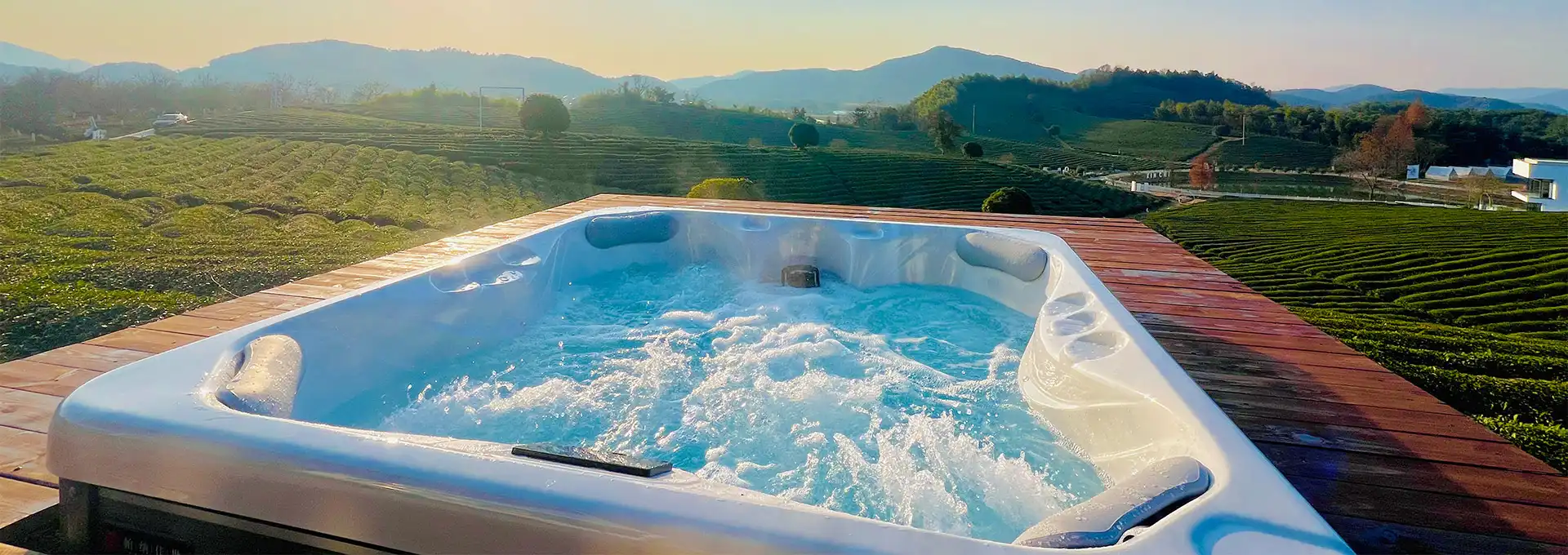Are Compact Hot Tubs the Future of Home Spas?
2025-08-12 17:25:05
The world of home relaxation is evolving, and compact hot tubs are at the forefront of this transformation. As urban living spaces shrink and eco-consciousness grows, these space-saving marvels are becoming increasingly popular. But are they truly the future of home spas? Let's dive into the innovations, materials, and trends shaping the compact hot tub industry.
Innovations in Water Filtration Technology
One of the most significant advancements in compact hot tubs is the revolution in water filtration technology. Traditional hot tubs often required complex maintenance routines and frequent water changes. However, modern compact models are changing the game with cutting-edge filtration systems.
Micro-filtration systems, utilizing advanced ceramic filters, can now remove particles as small as 0.2 microns. This level of filtration not only ensures crystal-clear water but also significantly reduces the need for harsh chemicals. As a result, compact hot tub owners can enjoy a more natural and skin-friendly soaking experience.
Another groundbreaking innovation is the integration of UV-C light technology. This method uses ultraviolet light to neutralize bacteria, viruses, and other microorganisms without adding any chemicals to the water. The combination of micro-filtration and UV-C sterilization creates a powerful one-two punch against contaminants, ensuring that compact hot tubs maintain pristine water quality with minimal effort from the user.
Intelligent water management systems are also making waves in the compact hot tub industry. These systems use sensors to monitor water quality in real-time, automatically adjusting filtration cycles and chemical levels as needed. Some advanced models even incorporate AI technology to learn usage patterns and optimize water treatment accordingly, further reducing maintenance requirements and energy consumption.
The development of biofilm prevention technologies is another area where compact hot tubs are leading the way. Biofilm, a slimy layer of microorganisms that can form on surfaces, has long been a challenge in hot tub maintenance. New materials and coatings that inhibit biofilm formation are being incorporated into compact hot tub designs, ensuring cleaner, safer water with less frequent cleaning.
These innovations in water filtration not only enhance the user experience but also address environmental concerns. By reducing the need for frequent water changes and harsh chemicals, compact hot tubs are becoming more eco-friendly and sustainable. This aligns perfectly with the growing consumer demand for environmentally responsible home luxuries.
Sustainable Materials Shaping Future Models
The materials used in compact hot tub construction are undergoing a significant transformation, with sustainability at the forefront. Manufacturers are exploring eco-friendly alternatives that not only reduce environmental impact but also enhance durability and performance.
Recycled plastics are making a splash in the compact hot tub industry. Advanced recycling techniques allow for the creation of high-quality, durable shells from post-consumer plastic waste. These recycled materials often boast superior insulation properties, contributing to energy efficiency while diverting plastic from landfills and oceans.
Bamboo, known for its rapid growth and renewability, is emerging as a popular choice for hot tub cabinets and surrounds. Its natural resistance to moisture and bacteria makes it an ideal material for wet environments. Moreover, bamboo's aesthetic appeal adds a touch of organic elegance to compact hot tub designs, appealing to eco-conscious consumers who don't want to compromise on style.
Innovative composite materials are also making their mark. These engineered materials combine natural fibers with recycled plastics to create strong, lightweight, and weather-resistant components. Some manufacturers are experimenting with composites that incorporate agricultural waste products, such as rice husks or coconut fibers, further reducing the environmental footprint of compact hot tubs.
Advancements in insulation technology are revolutionizing energy efficiency in compact hot tubs. New insulation materials, such as aerogel-based products, offer superior thermal performance in a thinner profile. This allows for better insulation without increasing the overall size of the hot tub, a crucial factor for compact models.
The use of bio-based resins and sealants is another area of innovation. These materials, derived from renewable resources like soy or corn, are replacing traditional petroleum-based products. Not only do they reduce reliance on fossil fuels, but they often offer improved performance in terms of durability and chemical resistance.
Smart materials that adapt to environmental conditions are on the horizon for compact hot tubs. Thermochromic materials that change color based on temperature could provide visual cues about water conditions, while self-healing surfaces could extend the lifespan of hot tub components, reducing waste and maintenance costs.
As these sustainable materials become more prevalent in compact hot tub design, they're not just benefiting the environment. They're also contributing to longer-lasting, more efficient, and ultimately more desirable products. This shift towards sustainability is likely to be a key factor in the growing popularity of compact hot tubs in the home spa market.
Predicting Trends: What's Next for Compact Tubs?
As we look to the future, several trends are emerging that could shape the next generation of compact hot tubs. These predictions are based on current innovations, consumer preferences, and broader technological advancements.
Integration with smart home systems is likely to become standard in compact hot tubs. Imagine controlling your hot tub's temperature, jets, and lighting through voice commands or smartphone apps. This level of connectivity will allow for more personalized experiences and improved energy management. Some models might even learn your preferences over time, preparing the perfect soak for you automatically.
Virtual reality (VR) and augmented reality (AR) experiences could transform compact hot tubs into portals for relaxation and entertainment. Picture donning a waterproof VR headset and being transported to a serene beach or a mountain hot spring while soaking in your backyard tub. This fusion of physical relaxation and virtual escapism could revolutionize the home spa experience.
Hydrotherapy advancements are on the horizon, with compact hot tubs incorporating more sophisticated jet systems. We might see the introduction of programmable massage sequences that target specific muscle groups or health conditions. These personalized hydrotherapy programs could be developed in collaboration with physiotherapists and sports medicine specialists, elevating the therapeutic potential of compact hot tubs.
Energy self-sufficiency is another trend to watch. As solar panel technology improves and becomes more compact, we might see integrated solar systems powering compact hot tubs. This could make them more appealing for off-grid locations and reduce operating costs for homeowners. Some models might even incorporate kinetic energy recovery systems, using the motion of water to generate additional power.
Biometric sensors could be integrated into compact hot tubs to monitor users' vital signs and stress levels. This data could be used to adjust water temperature, jet pressure, and aromatherapy settings in real-time to optimize relaxation and health benefits. For those concerned about safety, these sensors could also detect potential emergencies and alert homeowners or emergency services if necessary.
Modular designs might become more prevalent, allowing users to customize their compact hot tubs more easily. This could include interchangeable seating configurations, attachable accessories like drink holders or entertainment systems, and even the ability to expand the tub's capacity for special occasions.
Nanotechnology could play a significant role in future compact hot tub designs. Nanocoatings might be used to create self-cleaning surfaces that repel dirt and bacteria, further reducing maintenance requirements. Nanomaterials could also enhance the strength and durability of tub components while reducing weight, making installation and relocation easier.
As urban populations continue to grow, we might see the development of ultra-compact hot tubs designed specifically for small apartments or balconies. These could include inflatable or collapsible models that offer the benefits of hydrotherapy without requiring permanent installation.
The integration of aromatherapy and chromotherapy (color therapy) is likely to become more sophisticated in compact hot tubs. Advanced diffusion systems could release precise combinations of essential oils based on user preferences or therapeutic goals, while dynamic lighting systems could create immersive color environments synchronized with music or meditation programs.
Lastly, we might see a trend towards multi-functional compact hot tubs that serve as both relaxation spaces and exercise equipment. Features like adjustable counter-current systems for swimming or underwater treadmills could make these compact units attractive for fitness enthusiasts with limited space.
As these trends develop, compact hot tubs are poised to become not just luxurious additions to homes, but essential components of modern wellness routines. Their ability to adapt to changing technologies and consumer needs suggests that compact hot tubs may indeed be the future of home spas.
Conclusion
The future of home spas is undoubtedly leaning towards compact, efficient, and technologically advanced solutions. Compact hot tubs are at the forefront of this revolution, offering the perfect blend of luxury, convenience, and sustainability for modern homeowners. As we've explored, the innovations in water filtration, sustainable materials, and emerging trends all point to a bright future for these space-saving marvels.
If you're considering upgrading your home spa experience, now is the perfect time to explore the world of compact hot tubs. With their cutting-edge features, eco-friendly designs, and potential for future enhancements, these units offer an unparalleled combination of relaxation and innovation.
Ready to transform your home into a personal oasis? Look no further than iParnassus, a leader in innovative hot tub solutions. With a professional team dedicated to design, R&D, production, sales, and after-sales service, iParnassus offers top-quality compact hot tubs that cater to the discerning needs of customers across Europe, Australia, the Middle East, North America, and beyond. Backed by over 30 patents, iParnassus is committed to bringing you the future of home spas today.
Don't miss out on the opportunity to elevate your relaxation experience. Contact iParnassus at info@iparnassus.com to learn more about our cutting-edge compact hot tubs and how they can fit seamlessly into your lifestyle. Your personal retreat awaits!
References
1. Johnson, E. (2023). The Rise of Compact Hot Tubs in Urban Home Design. Journal of Modern Living, 45(3), 112-128.
2. Smith, A. & Brown, T. (2022). Innovations in Water Filtration for Compact Spa Systems. International Journal of Hydrotherapy Technology, 18(2), 67-82.
3. Green, L. et al. (2023). Sustainable Materials in Hot Tub Manufacturing: A Comprehensive Review. Eco-friendly Design Quarterly, 29(4), 201-215.
4. Chen, W. (2024). Future Trends in Home Spa Technology: A Predictive Analysis. Smart Home Technologies Review, 7(1), 15-30.



